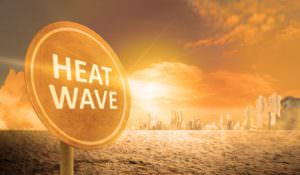Since we discussed in our prior blog this month that Cal/OSHA sets a standard for the nation on worker protection, let’s go back to specifics as a good example to follow. In 2006, Cal/OSHA (California’s Division of Occupational Safety and Health, better known as Cal/OSHA) mandated regulations aimed at heat illness prevention. This includes “high-heat procedures” that focus on:
- Observation – following the weather to know when the heat is coming and implementing a buddy system that encourages onsite workers to look out for each other
- Communication (including pre-shift meetings before the commencement of work to review the high heat procedures)
- Taking proactive action – encouraging employees to drink plenty of water, and reminding employees of their right to take a cool-down rest when necessary.
A heatwave, especially when temperatures are over 95°F, requires more. This is outlined in section (e) from the Cal/OSHA site: https://www.dir.ca.gov/title8/3395.html. To summarize in the most basic terms, it requires California employers with agricultural workers, construction workers, landscapers, and any other industry with outdoor workers to provide more than adequate water, shade, rest breaks, and training. This rule applies when temperatures are higher than 80°F degrees, but it should be noted additional requirements apply when the outdoor temperature exceeds 95°F. At that particular temperature, a more stringent set of rules are in place to prevent heat illness.
To stand in compliance with these regulations above 95°F, you must have in place “an effective Injury and Illness Prevention Program (IIPP)” as stipulated by Cal/OSHA. Additionally, besides providing water and first aid, “the employer must ensure that the employee takes a minimum ten-minute net preventative cool-down rest period every two hours. If the workday will extend beyond eight hours, then an additional preventative cool-down rest period will be required at the conclusion of the eighth hour of work; and if the workday extends beyond ten hours, then another preventative cool-down rest period will be required at the conclusion of the tenth hour and so on. For purposes of this section, a preventative cool-down rest period has the same meaning as the “recovery period” in Labor Code Section 226.7(a).”
Meeting these requirements is part of the fundamentals of being compliant, but employers should also evaluate cooling options to help ensure employees stay safe and productive at higher temperatures. Given A/C is not a practical option outside, utilizing an energy-efficient cooling method such as a portable evaporative cooler may be a viable solution. Evaporative coolers provide natural cooling and can be operated with a generator to deliver a comfortable cool-down space for employees. Portacool evaporative coolers come in a range of sizes, operate with a standard 110-V, and are equipped with heavy-duty casters to provide easy mobility for achieving cooling where it is needed.
Planning ahead makes a difference. Take the time BEFORE a heatwave hits to plan for protecting your workers. It may be the difference between life and death.
*Article sources:
https://www.dir.ca.gov/dosh/heatIllnessQA.html#item-4; http://www.dir.ca.gov/dosh/etools/08-
006/EWP_mwc.htm; https://www.dir.ca.gov/title8/3395.html;









